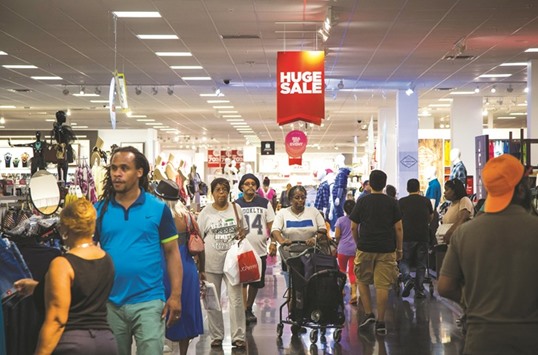Consumer purchases advanced for a fourth straight month in July, bolstered by stronger income gains, sending the biggest part of the US economy to a solid third-quarter start.
The 0.3% rise matched forecasts and followed a 0.5% increase the prior month that was revised up, a Commerce Department report showed yesterday in Washington. Incomes rose 0.4%, the most in three months.
Americans’ continued spending, supported by job growth and low fuel costs, is likely to support what economists project will be a rebound in expansion this quarter after the weakest first half since 2011.
If another report this Friday shows robust job gains in August, it would further boost expectations for Federal Reserve policy makers to raise interest rates next month.
“Consumers are the strength of the economy right now,” Russell Price, a senior economist at Ameriprise Financial Inc in Detroit, said before the report.
“That’s going to continue in the third quarter. We have ongoing job growth, wage growth and higher asset values.”
Adjusted for the effect of price changes, spending increased 0.3%, exceeding the median estimate of economists for a 0.2% rise. The prior month’s advance was revised upward to 0.4% from 0.3%.
Purchases of durable goods, which include automobiles, increased 1.9% in July after adjusting for inflation, the biggest gain in three months. That followed a 0.9% advance. Spending on non-durable goods, which include gasoline, fell 0.1%, the first drop since February.
Household outlays on services rose 0.2% after adjusting for inflation. The category includes tourism, legal help, healthcare, and personal care items such as haircuts, and is typically difficult for the government to estimate accurately.
Disposable income adjusted for inflation grew 0.4%, the most this year, after a 0.2% gain in June. Consumption accounts for about 70% of the economy.
Gross domestic product expanded at a 1.1% annualised rate from April through June, less than initially estimated, Commerce Department figures showed on Friday.
Household purchases jumped 4.4%, the most since late 2014, adding 2.9 percentage points to growth.
Projections for July consumer spending ranged from an increase of 0.1% to 0.4%, according to the Bloomberg survey. The previous month’s reading was initially reported as a gain of 0.4%.
Economists’ median estimate for incomes called for a rise of 0.4%, after a previously reported 0.2% gain.
The saving rate increased to 5.7% from 5.5%. Wages and salaries rose 0.5% for a second month.
The Fed’s preferred measure of inflation remained well contained, the report showed.
The price gauge based on the personal consumption expenditures index was unchanged from the prior month and was up 0.8% from a year earlier.
The core price measure, which excludes food and fuel, rose 0.1% from the prior month and was up 1.6% from July 2015. Inflation hasn’t reached the Fed’s 2% goal since 2012.

Customers shop at a JC Penney store at the Gateway Shopping Center in the Brooklyn borough of New York. The 0.3% rise in consumer spending in the US matched forecasts and followed a 0.5% increase the prior month that was revised up, a Commerce Department report showed in Washington yesterday.


